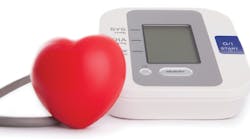I’ve noticed a recent trend in my patients when I inquire about their last primary care appointment. Many report that they no longer have a primary care doctor because they have retired or relocated, or the patient is simply overdue because of the long waitlists to get in. When I began researching, I found that the Prevent Cancer Foundation recently reported “50 percent of Americans had an in-person medical appointment that they missed, delayed, or canceled.”1 Preventive visits are essential for our patients’ health and early detection of disease indicators. The role of the dental hygienist is more critical now than ever. Our patients need us to be dedicated about providing potentially lifesaving screenings—such as measuring blood pressure—that have been identified as the standard of care for registered dental hygienists.
“The silent killer”
High blood pressure is known as “the silent killer” because most patients are asymptomatic; nearly half of Americans fall into this category.2 Hypertension increases the risks of heart attack and stroke, which are the leading causes of death in the United States.2 In 2021, hypertension was a primary or contributing cause of 691,095 deaths in the US.3 With the clamoring statistics around lack of preventive care and the potential rise in blood pressure, screenings should never be skipped during patients’ preventive visits.
COVID-19 and rising blood pressure
In August 2023, the American Heart Association released data suggesting “alarming results” depicting “a major health burden.” Researchers analyzed 45,000 people infected with the COVID-19 virus and found an association between the virus and developing high blood pressure in patients with no prior history of high blood pressure.2 Study patients returned for a follow-up three to nine months after testing positive for the flu or COVID-19. The patients who were hospitalized with COVID-19 were twice as likely to develop persistent hypertension than those hospitalized for the flu.2
Also by the author ... The first steps to treating the root cause of dental dysbiosis
An additional study followed more than 150,000 veterans who tested positive for COVID-19 between March 2020 and January 2021; these individuals were found to be 63% more likely to develop a cardiovascular issue.4 It’s important to note that the study was adjusted to disqualify patients with preexisting medical conditions. Medical histories should be adjusted to include the history of COVID-19 and inquiries about long-term COVID-19 symptoms.
Integration chairside
A blood pressure screening is most accurate with a traditional blood pressure cuff around the upper arm. This can be achieved via an automatic monitor cuff or a manual reading. Choosing a method that is clear and easy to read will streamline your workflow as well as enhance patient interaction. A less precise but straightforward way to be compliant with blood pressure screenings on patients ages 3 and older is via a wrist cuff. The Cleveland Clinic estimates that one in 25 kids ages 12–19 has hypertension.5 Elevated blood pressure in children ages 13 and over is 120/80–129/<80 mm Hg; stage one hypertension is 130/80–139/80 mm Hg; and stage two hypertension is ≥140/90 mm Hg.6
For the most accurate screening, the patient should avoid caffeine 30 minutes prior to the screening, sit quietly for five minutes with legs uncrossed and back supported, have the cuff over bare skin, and avoid talking during the reading.5 To improve accuracy, leave the deflated cuff in place and wait a minute before taking a second reading. If the readings are close to one another, take the average of three readings.5,6 It is common for patients to have different readings depending on the time of day so it is essential to note the time the blood pressure reading was conducted. See Table 1.6
When to refer and when to dismiss
According to the American Dental Association, patients with blood pressure levels of <160/100 can receive care with no modifications. For patients with measurements >160/100, it is advised to take the blood pressure three times, and then take the average of the measurements. If the reading lowers, care can be provided with medical clearance. If the measurements continue to be consistent, it is advised to dismiss the patient if they are there for elective treatment and to seek consultation from a physician.7
Also by the author ... Long COVID and its systemic health impacts
Regarding emergency dental care, no treatment modifications are needed for readings <160/100. When a patient’s blood pressure readings measure >160/100, repeat the measurement three times and take the average of the measurements. If the reading lowers, treatment can be conducted or you can proceed with medical clearance.7 If the readings are confirmed to be a systolic pressure of 160–180 mm Hg and/or a diastolic pressure of 100–109 mm Hg, and the procedure can induce anxiety contributing to hypertension, the patient should be monitored closely.7
Implement an anxiety-reducing technique with patients who have elevated readings. For a confirmed systolic pressure >180 mm Hg or a diastolic pressure >109 mm Hg, have the patient consult their physician before treatment.7 Patients with a blood pressure >180/100 mm Hg should be referred to their physician as soon as possible or seek urgent care evaluation if they are symptomatic.7
When treating patients with hypertension, it’s essential to consider vasoconstrictors, although they are rarely contraindicated. It’s common to limit the use of epinephrine to 0.04 mg in adults, which is the equivalent of7:
- One cartridge of anesthetic containing 1:50,000 epinephrine
- Two cartridges of anesthetic containing 1:100,000 epinephrine
- Four cartridges of anesthetic containing 1:200,000 epinephrine
As dental hygienists, we can prevent disease in its early stages and provide early detection of disease indicators. In dentistry we often think of screenings for oral cancer, caries, and gum disease, but blood pressure screenings are one of the most critical assessments we can provide for patients. Remember, we do way more than just clean teeth. We are essential health-care providers for preventive screenings and a pivotal component in identifying evidence of disease at its earliest stages. We must not skip the potentially lifesaving screenings for oral cancer and blood pressure that are deemed our standard of care.
Editor's note: This article appeared in the January/February 2024 print edition of RDH magazine. Dental hygienists in North America are eligible for a complimentary print subscription. Sign up here.
References
- Rodriguez S. COVID-19 takes a toll on patient access to preventive cancer screenings. PatientEngagementHIT. March 4, 2022. Accessed November 1, 2023. https://patientengagementhit.com/news/covid-19-takes-a-toll-on-patient-access-to-preventive-cancer-screenings
- COVID-19 may trigger new-onset high blood pressure. American Heart Association. August 21, 2023. Updated August 25, 2023. Accessed November 1, 2023. https://newsroom.heart.org/news/covid-19-may-trigger-new-onset-high-blood-pressure
- Mortality data on CDC Wonder. National Center for Health Statistics. Centers for Disease Control and Prevention. Updated September 8, 2023. Accessed November 1, 2023. https://wonder.cdc.gov/mcd.html
- Liuzzo G, Volpe M. SARS-CoV-2 infection markedly increases long-term cardiovascular risk. Eur Heart J. 2022;43(20):1899-1900. doi:10.1093/eurheartj/ehac168
- High blood pressure in children. Cleveland Clinic. Updated May 2, 2023. Accessed November 17, 2023. https://my.clevelandclinic.org/health/diseases/21150-high-blood-pressure-in-children
- Reading the new blood pressure guidelines. Harvard Health Publishing. November 16, 2021. https://www.health.harvard.edu/heart-health/reading-the-new-blood-pressure-guidelines
- Department of Scientific Information, Evidence Synthesis & Translation Research, ADA Science & Research Institute, LLC. Hypertension (high blood pressure). American Dental Association. Updated November 1, 2022. Accessed November 17, 2023. https://www.ada.org/en/resources/research/science-and-research-institute/oral-health-topics/hypertension
Amber Auger, MPH, RDH, is a practicing dental hygienist and creator of Thrive in the OP. Additionally, she is the editorial director of the RDH Graduate newsletter, host of #AskAmberRDH, the 2019 Sunstar/RDH Award of Distinction recipient, and an international speaker. Amber specializes in the integration of the latest science into practical protocols for chairside implementation, and can be reached at [email protected].








